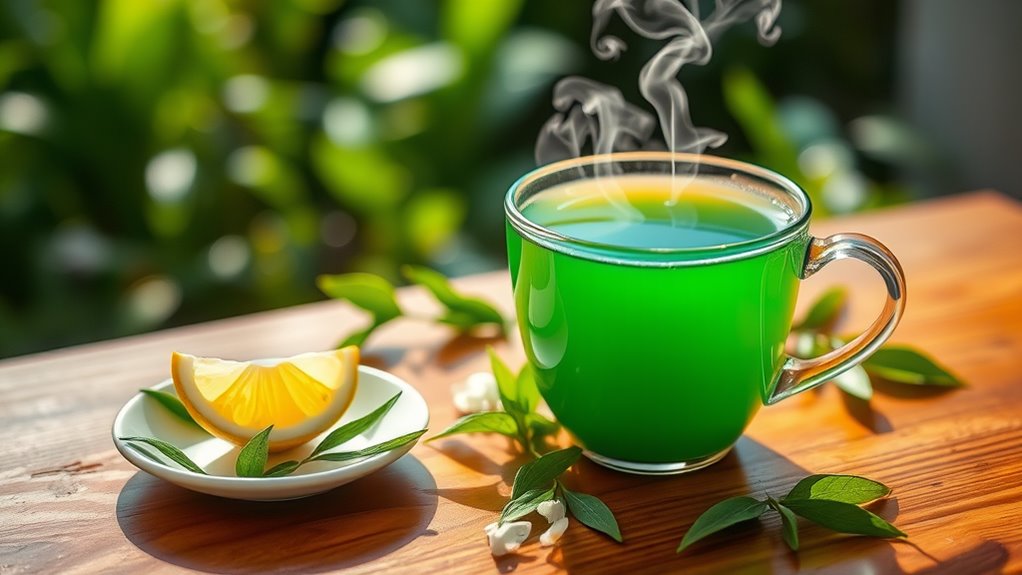
Green tea tantalizes your taste buds with its fresh, grassy notes and delicate sweetness. You'll notice a smooth, vegetal flavor that embodies leafy greens, particularly in varieties like Sencha. The nutty, toasted undertones in Chinese greens add warmth and complexity, while the umami richness creates a savory depth. Subtle hints of floral or fruity notes might surprise you, enriching the experience further. There's a whole world of flavors and nuances waiting to be explored.
The taste of green tea unfolds like a delicate whisper, inviting you to explore its multifaceted flavor profile. As you take your first sip, you'll likely notice the invigorating, grassy notes that dance on your palate, reminiscent of freshly cut grass or steamed greens. This vivid flavor often comes from Japanese varieties like Sencha, where minimal processing retains the tea's natural chlorophyll and freshness. The vegetal taste can evoke thoughts of leafy greens, like spinach or even green beans, providing a crisp and lush experience that varies depending on the tea type and growing conditions.
The taste of green tea reveals grassy notes, evoking freshness and vitality with each sip, inviting you to explore its vibrant essence.
As you investigate deeper into the experience, you might detect subtle sweetness that balances out the grassy notes. This sweetness, which can range from mild to pronounced, enhances the overall profile, creating a symphony of flavors. Shaded teas, such as Kabuse Sencha, often boast amplified sweetness due to the prolonged shading before harvest, adding a layer of complexity to your tasting journey. The interplay between sweetness and dryness can shift with each variety, guiding your taste buds through various sensations.
You might also stumble upon nutty and toasted flavors that emerge from Chinese green teas like Longjing (Dragonwell) or Biluochun. Here, the pan-firing process can introduce rich, toasted notes that lend a warm, comforting quality to the cup. The degree of oxidation plays a vital role in determining how pronounced these flavors become, leading to a clean, crisp umami taste that dances alongside nutty undertones, reminiscent of roasted nuts or toasted grains.
As you sip, keep an eye out for the umami and savory flavors, particularly in Japanese green teas. The depth of umami, often associated with protein-rich foods, adds a brothy richness that elevates the tasting experience. Shaded teas like Gyokuro and matcha powder are particularly abundant in this savory depth, showcasing the high amino acid content that contributes to a complex flavor profile. This umami essence intertwines beautifully with the other elements, creating a harmonious balance.
You may even encounter floral and fruity notes, though they're less commonly found in green tea. If you try Jasmine green tea, for instance, you'll notice delicate floral aromas that envelop your senses, adding a fragrant layer to the taste. Fruity undertones, ranging from citrus to tropical fruits, can occasionally pop up, but they often play a supporting role rather than taking center stage.
Ultimately, the taste of green tea is an intricate tapestry woven from leafy, grassy, sweet, nutty, umami, floral, and occasionally fruity elements. Each sip invites you to savor the subtleties and variations, encouraging a deeper appreciation for this remarkable beverage. With every cup, you set forth on a flavorful adventure, discovering the unique characteristics that each type of green tea has to offer.
Conclusion
So, if you've been hesitant to try green tea because you think it might be too bitter or grassy, think again! With its delicate balance of earthy notes and subtle sweetness, green tea offers a revitalizing experience that can vary by type. Imagine sipping a warm cup that dances on your palate, leaving a soothing aftertaste. It's not just a drink; it's a moment of serenity. Give it a chance—your taste buds might just thank you!



